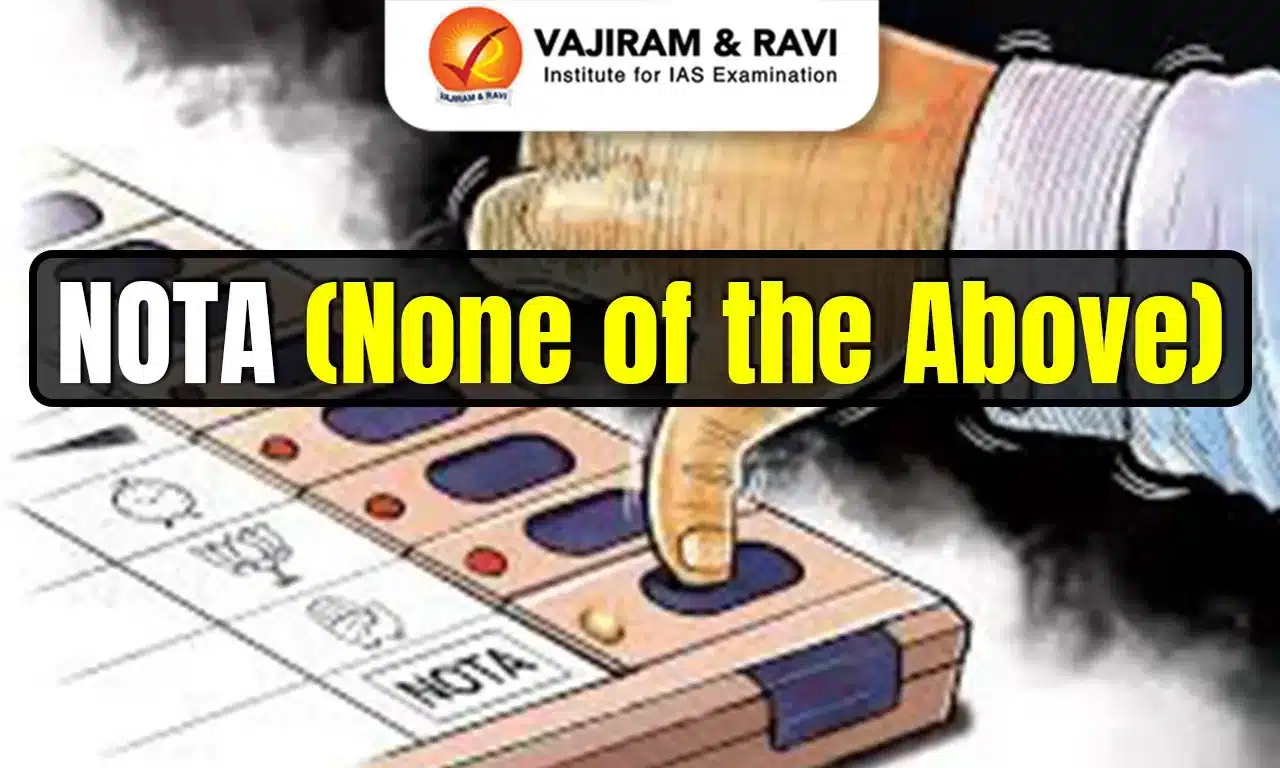NOTA (None of the Above) Latest News
The Vidhi Centre for Legal Policy recently filed a PIL seeking mandatory inclusion of NOTA in all elections, including constituencies with only one candidate.
About NOTA
- NOTA (None of the Above) is a voting option that allows voters to reject all contesting candidates in an election while still maintaining the secrecy of their choice.
- It was introduced as a result of the 2013 Supreme Court judgment in the PUCL vs Union of India case, establishing it as a symbol of voter discontent.
- First implemented in the 2013 Assembly elections in Chhattisgarh, Mizoram, Rajasthan, Delhi, and Madhya Pradesh, and later in the 2014 General Elections.
Current Legal Status and Function of NOTA
- Votes cast under NOTA are counted, but they are treated as invalid votes.
- Even if NOTA receives the highest number of votes, the candidate with the second-highest valid votes is declared elected.
- Thus, NOTA does not impact the election outcome, but serves as a tool for democratic expression.
Election Commission’s Position on NOTA
- The Election Commission (EC) opposed making NOTA mandatory in all elections.
- It cited that uncontested elections are infrequent:
- Only 6 such cases since 1971 in Lok Sabha elections.
- Only 9 cases since 1952 where candidates were elected unopposed.
- The EC argued that making NOTA compulsory would require legislative amendments to the:
- Representation of the People Act, 1951, and
- Conduct of Election Rules, 1961.
NOTA (None of the Above) FAQs
Q1: What does NOTA stand for in Indian elections?
Ans: NOTA stands for “None of the Above,” allowing voters to reject all candidates on the ballot.
Q2: When was NOTA introduced in Indian elections?
Ans: NOTA was introduced in India in 2013 following a Supreme Court directive for better voter choice.
Q3: Does NOTA affect the outcome of an election in India?
Ans: No, even if NOTA receives the majority, the candidate with the highest votes still wins.
Source: TH
Last updated on November, 2025
→ Check out the latest UPSC Syllabus 2026 here.
→ Join Vajiram & Ravi’s Interview Guidance Programme for expert help to crack your final UPSC stage.
→ UPSC Mains Result 2025 is now out.
→ UPSC Notification 2026 is scheduled to be released on January 14, 2026.
→ UPSC Calendar 2026 is released on 15th May, 2025.
→ The UPSC Vacancy 2025 were released 1129, out of which 979 were for UPSC CSE and remaining 150 are for UPSC IFoS.
→ UPSC Prelims 2026 will be conducted on 24th May, 2026 & UPSC Mains 2026 will be conducted on 21st August 2026.
→ The UPSC Selection Process is of 3 stages-Prelims, Mains and Interview.
→ UPSC Result 2024 is released with latest UPSC Marksheet 2024. Check Now!
→ UPSC Prelims Result 2025 is out now for the CSE held on 25 May 2025.
→ UPSC Toppers List 2024 is released now. Shakti Dubey is UPSC AIR 1 2024 Topper.
→ UPSC Prelims Question Paper 2025 and Unofficial Prelims Answer Key 2025 are available now.
→ UPSC Mains Question Paper 2025 is out for Essay, GS 1, 2, 3 & GS 4.
→ UPSC Mains Indian Language Question Paper 2025 is now out.
→ UPSC Mains Optional Question Paper 2025 is now out.
→ Also check Best IAS Coaching in Delhi
Tags: NOTA (None of the Above) prelims pointers upsc prelims current affairs

















